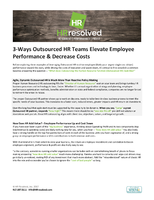NFPA publishes annual U.S. Fluid Power Industry report.
Press Release Summary:
According to Annual Report on the U.S. Fluid Power Industry, fluid power is a workhorse of the U.S. economy—a crosscutting technology of choice for dozens of industries and hundreds of applications. In 2015, the manufacture of fluid power components was a $19.3 billion industry. It is estimated that 846 companies in the U.S. employ more than 72,500 people in the manufacture of fluid power components, representing an annual payroll of more than $4.7 billion.
Original Press Release:
NFPA Publishes Second Annual Report on the U.S. Fluid Power Industry
Milwaukee, WI — Fluid power is a workhorse of the U.S. economy—a crosscutting technology of choice for dozens of industries and hundreds of applications. That’s one of the many conclusions in the new Annual Report on the U.S. Fluid Power Industry, published by the National Fluid Power Association. The report reviews both the size and economic impact of the industry, as well as explores the energy consumption, best practices and current R&D directions of fluid power technology.
“Some people refer to fluid power as ‘the hidden giant,’” said Eric Lanke, NFPA President/CEO. “And by that they generally mean that the industry is not well understood or appreciated for the significant impact it has on our economy and our modern way of life. This report, the second annual report NFPA has published on this topic, is designed to help address that situation. Our goal is to raise awareness and public understanding of the impact of our industry.”
The report’s Executive Summary describes many of the report’s conclusions, including:
In 2015, the manufacture of fluid power components was a $19.3 billion industry.
The U.S. fluid power industry is strongly competitive around the world, with 2015 exports valued at $5.7 billion.
It is estimated that 846 companies in the United States employ more than 72,500 people in the manufacture of fluid power components, representing an annual payroll of more than $4.7 billion.
Fluid power has a significant downstream economic impact. Ten key industries that depend on fluid power are estimated to represent more than 23,700 companies in the United States, employing more than 884,200 people with an annual payroll of more than $56.1 billion.
Fluid power and the industries it serves depend on a highly-educated workforce. Investments in new fluid power education and training resources are needed.
Fluid power systems consume significant amounts of energy, and increases in overall energy efficiency are possible through the adoption of best practices and focused R&D programs.
Existing technologies and best practices have been shown to reduce energy use in fluid power systems, in some cases by up to 30% or more.
Fluid power has an active industry/academic coalition that focuses on research and emerging technologies. Recent breakthroughs have been made in increasing energy efficiency, increasing energy storage capabilities, and reducing the size of fluid power components and systems.
Future directions of fluid power research will focus on its use in off-highway vehicles, human scale systems, and advanced manufacturing.
Copies of the report can be downloaded from the NFPA website at: http://www.nfpa.com/fluidpower/annual-report-on-fluidpower-industry.aspx
NFPA representatives are available to speak to companies, associations, government agencies, universities, and other groups interested in learning more about the report and the fluid power industry.
To make an inquiry, contact Lanke at 414-778-3351 or elanke@nfpa.com.
National Fluid Power Association
6737 W. Washington Street - Suite 2350
Milwaukee, WI 53214 USA
PHONE: +1 414 778 3344
FAX: +1 414 778 3361
E-MAIL: nfpa@nfpa.com
INTERNET: http://www.nfpa.com
About the NFPA
NFPA provides a forum for the fluid power industry’s channel partners—manufacturers, suppliers, distributors, customers and educators. Its U.S. and multinational members work cooperatively in advancing hydraulic and pneumatic technology through the association’s many programs and initiatives.




